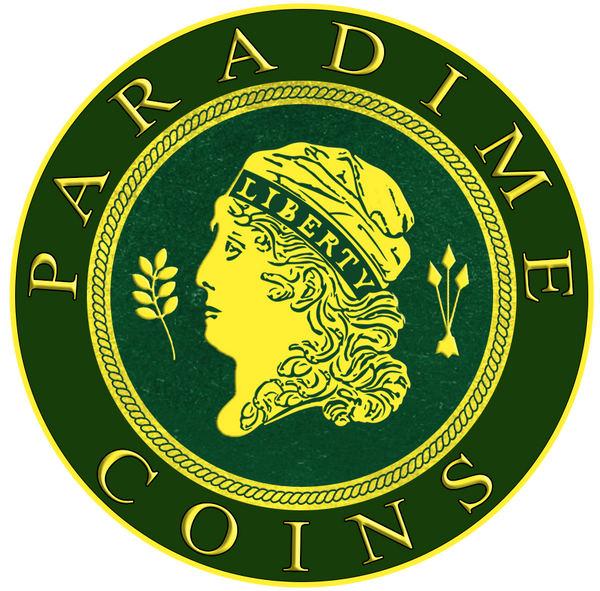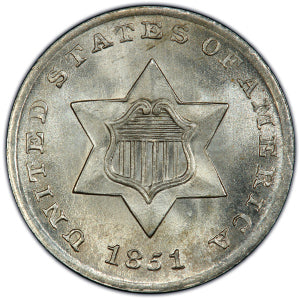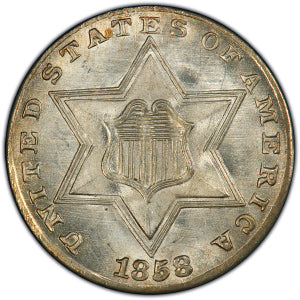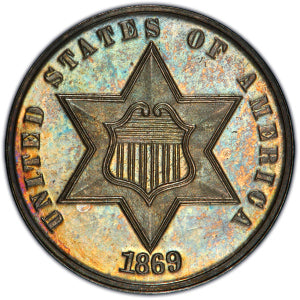Collection: Three Cent Silver (1851 - 1873)
No products found
View All Inventory
Silver Three-Cent Pieces (1851–1873): A Unique American Coinage History
The silver three-cent piece, also known as the "Trime," stands out as one of the most intriguing and short-lived U.S. coin denominations. Introduced in 1851 to simplify small transactions, particularly the purchase of postage stamps, these coins served a practical purpose ... Read More
Silver Three-Cent Pieces (1851–1873): A Unique American Coinage History
The silver three-cent piece, also known as the "Trime," stands out as one of the most intriguing and short-lived U.S. coin denominations. Introduced in 1851 to simplify small transactions, particularly the purchase of postage stamps, these coins served a practical purpose during a time when their purchasing power equaled approximately 50–75 cents today. This denomination, although discontinued after 1873, holds a special place in numismatic history for its distinctive designs and historical significance.
Why a Three-Cent Coin?
- Postage Stamp Purchase: The U.S. reduced domestic postage rates to three cents in 1851, creating demand for a coin to facilitate stamp purchases.
- Small Denomination Need: It filled a gap between the large cent and the half dime.
- Civil War Coin Shortages: The Trime's utility was reinforced by the need for small change during the Civil War.
Design and Variations
Type 1: No Star Outline (1851–1853)
- Designer: James Barton Longacre
- Composition: 75% silver, 25% copper
- Key Features: A six-pointed star with a shield on the obverse and a "C" enclosing the Roman numeral III on the reverse.
-
Historical Notes:
- First U.S. coin without Miss Liberty on the obverse.
- Introduced a low-silver-content alloy to combat silver hoarding.
- Only branch mint issue: 1851-O (New Orleans Mint).
- Collectibility: Common in circulated grades but rare in sharply struck or uncirculated condition.
Type 2: Three Star Outlines (1854–1858)
- Composition: 90% silver, 10% copper (standard silver alloy).
-
Key Features:
- Added star outlines for improved design clarity.
- Introduced olive sprigs and arrows to the reverse.
-
Challenges:
- Striking difficulties persisted, making sharply struck examples exceedingly rare.
- 1855 stands out as a slightly better-struck issue.
- Collectibility: Rare in uncirculated condition; Proofs are major rarities.
Type 3: Two Star Outlines (1859–1873)
- Design Improvements: Simplified outlines and better striking techniques resolved earlier design issues.
-
Historical Notes:
- Coinage declined after 1862 due to Civil War hoarding.
- By 1873, the denomination was discontinued.
-
Collectibility:
- 1859–1862: Readily available in circulated grades.
- 1863–1873: Most surviving examples are Proofs or impaired Proofs due to low mintages.
Collecting Silver Three-Cent Pieces
For Beginners:
-
Type Set Collecting: Acquire one example of each type (I, II, III).
- Type I Recommendation: 1851, 1852, or 1853 for affordability.
- Type II Recommendation: Any date, but expect weak strikes in uncirculated grades.
- Type III Recommendation: 1861 or 1862 are most accessible in high grades.
For Advanced Collectors:
-
Complete Date and Variety Set:
- Focus on business strikes (1851–1862) and Proofs (1858–1873).
- Key rarities include 1856 Type II and 1868 Type III in business strike.
-
Uncirculated Examples:
- Prioritize sharply struck examples, especially for Type II coins, which are notoriously difficult to find in such condition.
Rarity and Investment Potential
- Proof Coins: Limited production from 1854 onward makes these highly desirable.
-
Key Dates:
- 1851-O: Only branch mint issue and a standout rarity.
- 1856 Type II: A sleeper rarity in uncirculated condition.
-
Historical Significance:
- Early Proof issues are numismatic treasures, with mintage numbers often under 300.
- Civil War-era coins reflect the economic challenges of the period.
Historical Context: The Coinage Act of 1873
The Coinage Act of 1873 marked the end of several denominations, including the silver three-cent piece. The discontinuation of this coin coincided with the rise of the bronze cent and five-cent nickel, which became more popular in commerce. The Trime, though no longer practical, remains a beloved piece of numismatic history.
Start Your Collection at ParadimeCoins.com
Paradime Coins offers a curated selection of silver three-cent pieces spanning all three design types. From affordable circulated coins to rare Proof issues, you'll find the perfect addition to your collection. Explore our inventory today and bring history to life at ParadimeCoins.com!
... Read Less







